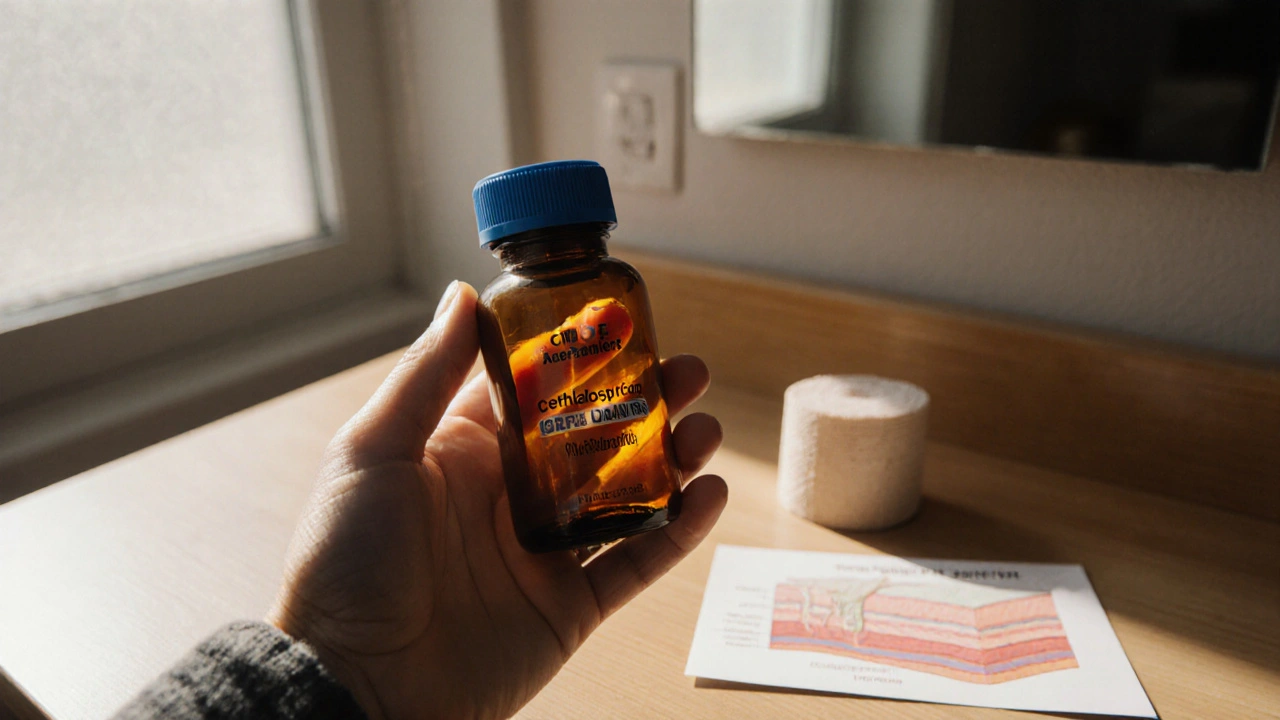Antibiotic Selection Tool
What type of infection do you have?
When you’re prescribed an oral antibiotic, the name on the bottle can feel like a foreign language. Keflex (Cephalexin) is a first‑generation beta‑lactam antibiotic that targets a broad range of gram‑positive bacteria, especially skin‑related infections. Deciding whether it’s the right choice or if another drug might work better depends on the infection, your health history, and how the medicines stack up against each other. Below you’ll find a side‑by‑side look at the most common alternatives, practical tips for choosing the right one, and answers to the questions patients ask most.
Key Takeaways
- Cephalexin is effective for uncomplicated skin, bone, and urinary infections but shares resistance concerns with other beta‑lactams.
- Amoxicillin offers a broader gram‑negative coverage, while Dicloxacillin targets penicillin‑resistant Staphylococcus aureus.
- Clindamycin and Azithromycin are useful when allergies to beta‑lactams exist.
- Dosage frequency and side‑effect profiles differ enough to influence adherence.
- Always consult your prescriber about kidney function, pregnancy, and possible drug interactions before switching.
What is Keflex (Cephalexin)?
Cephalexin is a first‑generation cephalosporin marketed under the brand name Keflex. It inhibits bacterial cell‑wall synthesis by binding to penicillin‑binding proteins, leading to cell death. Typical adult dosing is 250mg to 1g taken every 6-12hours, with a usual course of 5-10days. Its spectrum covers most gram‑positive cocci, including Staphylococcus aureus (non‑MRSA) and Streptococcus pyogenes.
How Cephalexin Works - Pharmacology in Plain English
Think of the bacterial cell wall as a brick wall; cephalexin is the mortar that stops the bricks from locking together. By preventing the cross‑linking of peptidoglycan layers, the bacteria become fragile and burst under normal pressure. It’s absorbed quickly from the gut, reaches peak plasma levels within an hour, and is excreted largely unchanged by the kidneys. Because of renal clearance, dosing adjustments are needed for patients with impaired kidney function.

Common Alternatives to Cephalexin
When a doctor considers a different drug, they look at the infection type, patient allergies, and local resistance patterns. Below are the top five oral antibiotics that often serve as substitutes.
- Amoxicillin a penicillin‑type antibiotic with good activity against both gram‑positive and many gram‑negative organisms
- Dicloxacillin a penicillinase‑resistant penicillin specifically crafted to fight beta‑lactamase‑producing Staphylococcus aureus
- Clindamycin a lincosamide antibiotic effective against anaerobes and many gram‑positive bacteria, useful in penicillin‑allergic patients
- Azithromycin a macrolide that concentrates inside cells, making it handy for respiratory and some soft‑tissue infections
- Doxycycline a tetracycline with broad‑spectrum activity, often chosen for atypical infections and tick‑borne diseases
Side‑Effect Snapshot - What to Expect
All antibiotics can cause upset stomach, but the frequency and severity vary.
- Cephalexin: mild diarrhea (≈10%); rare rash; occasional nausea.
- Amoxicillin: higher chance of GI upset, potential for Clostridioides difficile infection.
- Dicloxacillin: similar GI profile to amoxicillin, plus possible liver enzyme elevation.
- Clindamycin: notable risk of C. difficile colitis (≈5%); metallic taste.
- Azithromycin: usually well tolerated; occasional heart‑rate changes (QT prolongation) in high‑risk patients.
- Doxycycline: photosensitivity, esophageal irritation if not taken with water.
Comparison Table - Cephalexin vs Alternatives
| Antibiotic | Class | Typical Use Cases | Dosage (Adult) | Common Side Effects | Allergy Considerations |
|---|---|---|---|---|---|
| Cephalexin (Keflex) | First‑gen cephalosporin | Skin, bone, urinary tract | 250mg-1g every 6-12h | Diarrhea, nausea, rash | Cross‑reactivity ~5% with penicillin allergy |
| Amoxicillin | Penicillin | Respiratory, otitis media, dental | 500mg-1g every 8h | Diarrhea, rash, C. difficile | Contraindicated in penicillin‑allergic patients |
| Dicloxacillin | Penicillinase‑resistant penicillin | Penicillin‑resistant Staph infections | 500mg every 6h | Nausea, liver enzymes ↑ | Same as other penicillins |
| Clindamycin | Lincosamide | Anaerobic, skin, bone (pen‑allergy) | 300mg every 6h | High C. difficile risk, metallic taste | Safe for penicillin‑allergic patients |
| Azithromycin | Macrolide | Respiratory, chlamydia, some skin | 500mg day1, then 250mg daily ×4 | GI upset, QT prolongation | Alternative for pen‑allergy; watch cardiac meds |
| Doxycycline | Tetracycline | Atypical pneumonia, Lyme, acne | 100mg every 12h | Photosensitivity, esophagitis | Contraindicated in pregnant women, children <8y |
How to Choose the Right Antibiotic
There’s no one‑size‑fits‑all answer. Consider these practical factors:
- Infection type - Soft‑tissue infections (cellulitis) respond well to cephalexin; respiratory infections often need amoxicillin or azithromycin.
- Allergy profile - A documented penicillin allergy pushes you toward clindamycin or a macrolide.
- Local resistance data - In areas where MRSA is common, dicloxacillin or clindamycin may be preferred.
- Kidney function - Adjust cephalexin dose for reduced creatinine clearance; doxycycline is less reliant on renal excretion.
- Adherence - Once‑daily azithromycin improves compliance compared with three‑times‑daily regimens.
Safety Tips & When to Seek Help
Antibiotics are safe for most people, but watch for red‑flag signals:
- Severe diarrhea lasting more than two days - could signal C. difficile.
- Rash that spreads quickly or involves swelling - think allergic reaction.
- Persistent fever after 48‑72hours of therapy - infection may be resistant.
- New shortness of breath or palpitations while on azithromycin - possible heart rhythm issue.
If any of these appear, contact your GP or urgent care promptly.
Frequently Asked Questions
Can I take cephalexin if I'm allergic to penicillin?
Cross‑reactivity is low (about 5%), but you should still discuss it with your doctor. If you’ve had a severe anaphylactic reaction, a non‑beta‑lactam antibiotic such as clindamycin is usually safer.
How long does a typical cephalexin course last?
Most uncomplicated skin or urinary infections are treated for 5-7days. Bone infections may require 4-6weeks, always following the prescriber’s guidance.
Is it safe to use cephalexin while pregnant?
Cephalexin is classified as Pregnancy Category B in the UK, meaning animal studies haven’t shown risk and there’s no evidence of harm in pregnant women. Your doctor will weigh benefits against any theoretical risks.
What should I do if I miss a dose?
Take the missed dose as soon as you remember, unless it’s almost time for the next one. In that case, skip the missed dose-don’t double up.
Can I drink alcohol while on cephalexin?
Moderate alcohol doesn’t interact directly with cephalexin, but both can irritate the stomach. If you’re already experiencing nausea, it’s best to limit alcohol until you finish the course.


Kendra Barnett
October 14, 2025 AT 18:14If you’re weighing Keflex against other options, start by looking at the infection site and any allergies. Cephalexin works well for skin and bone infections when kidneys are functioning okay.
Warren Nelson
October 26, 2025 AT 07:01Totally agree – the spectrum of Cephalexin makes it a solid first‑line for uncomplicated skin stuff, and it’s generally easy on the gut compared to some of the clindamycin hype.
Jennifer Romand
November 6, 2025 AT 20:47One must concede that the allure of Keflex is somewhat overrated; its pharmacokinetic profile, while respectable, pales before the nuanced breadth of macrolides in atypical respiratory cases.
Kelly kordeiro
November 18, 2025 AT 10:34Indeed, while the empirical data supporting first‑generation cephalosporins such as Cephalexin is abundant, a discerning clinician must also contemplate the evolving resistance patterns that have rendered certain Staphylococcus aureus strains increasingly refractory to beta‑lactam therapy. Moreover, the pharmacodynamic parameters-namely, time‑dependent killing-necessitate adherence to dosing intervals that sustain serum concentrations above the MIC for the majority of the dosing period. It is paramount to recognize that renal excretion predominates, thereby mandating dosage adjustment in patients with compromised glomerular filtration rates to avert accumulation and potential neurotoxicity. In contrast, agents like Azithromycin exhibit extensive tissue penetration and a prolonged half‑life, granting once‑daily dosing convenience albeit at the expense of a modest increase in QT‑interval prolongation risk. The clinician’s armamentarium must therefore be tailored, integrating host factors such as pregnancy status-where Amoxicillin often supplants Cephalexin due to its more robust safety profile-and allergic predispositions, wherein Clindamycin emerges as a viable alternative despite its heightened association with Clostridioides difficile colitis. Furthermore, the cost-effectiveness analysis frequently tilts in favor of Cephalexin for uncomplicated infections, given its generic availability and lower acquisition cost relative to newer macrolides. Nevertheless, one cannot dismiss the merit of doxycycline in atypical presentations, particularly those demanding intracellular activity, albeit with the caveat of photosensitivity. Ultimately, the decision matrix should be anchored in a synthesis of microbiological data, patient comorbidities, and pragmatic considerations such as adherence potential, rather than a myopic reliance on any singular pharmacologic class.
Chris Fulmer
November 30, 2025 AT 00:21I’ve seen a lot of people confused about when to pick a beta‑lactam versus a macrolide. The key is to match the drug to the bug and the patient’s medical background.
William Pitt
December 11, 2025 AT 14:07Exactly, and if the person’s kidneys are fine, you can stick with the standard Cephalexin dose. If there’s a penicillin allergy, jump to Clindamycin or Azithro – just watch for C. diff risk.
Jeff Hershberger
December 23, 2025 AT 03:54Cephalexin’s beta‑lactam ring gives it a classic, albeit narrow, gram‑positive punch; the pharmacologic elegance is often marred by contemporary resistance.